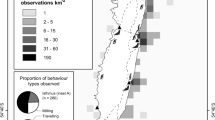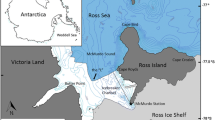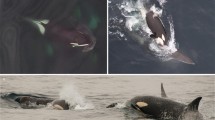Abstract
Killer whale (Orcinus orca Linnaeus, 1758) abundance in the North Pacific is known only for a few populations for which extensive longitudinal data are available, with little quantitative data from more remote regions. Line-transect ship surveys were conducted in July and August of 2001–2003 in coastal waters of the western Gulf of Alaska and the Aleutian Islands. Conventional and Multiple Covariate Distance Sampling methods were used to estimate the abundance of different killer whale ecotypes, which were distinguished based upon morphological and genetic data. Abundance was calculated separately for two data sets that differed in the method by which killer whale group size data were obtained. Initial group size (IGS) data corresponded to estimates of group size at the time of first sighting, and post-encounter group size (PEGS) corresponded to estimates made after closely approaching sighted groups. ‘Resident’-type (fish-eating) killer whales were more abundant than the ‘transient’-type (mammal-eating). Abundance estimates of resident killer whales (991 [95% CI = 379–2,585] [IGS] and 1,587 [95% CI = 608–4,140] [PEGS]), were at least four times greater than those of the transient killer whales (200 [95% CI = 81–488] [IGS] and 251 [95% CI = 97–644] whales [PEGS]). The IGS estimate of abundance is preferred for resident killer whales because the estimate based on PEGS data may show an upward bias. The PEGS estimate of abundance is likely more accurate for transients. Residents were most abundant near Kodiak Island in the northern Gulf of Alaska, around Umnak and Unalaska Islands in the eastern Aleutians, and in Seguam Pass in the central Aleutians. This ecotype was not observed between 156 and 164°W, south of the Alaska Peninsula. In contrast, transient killer whale sightings were found at higher densities south of the Alaska Peninsula between the Shumagin Islands and the eastern Aleutians. Only two sightings of ‘offshore’-type killer whales were recorded during the surveys, one northeast of Unalaska Island and the other south of Kodiak Island. These are the first estimates of abundance of killer whale ecotypes in the Aleutian Islands and Alaska Peninsula area and provide a baseline for quantifying the role of these top predators in their ecosystem.


Similar content being viewed by others
Notes
Available from Robert Holland (Robert.Holland@noaa.gov) at the Southwest Fisheries Science Center (SWFSC), La Jolla, CA, USA.
References
Akaike H (1973) Information theory and an extension of the maximum likelihood principle. In: International symposium on information theory, 2nd edn. Akadèemiai Kiadi, Budapest, pp 267–281
Baird RW (2000) The killer whale foraging specializations and group hunting. In: Mann J, Connor RC, Tyack PL, Whitehead H (eds) Cetacean societies. Field studies of dolphins and whales. The University of Chicago Press, Chicago, pp 127–153
Baird RW, Stacey PJ (1988) Variation in saddle patch pigmentation in populations of killer whales (Orcinus orca) from British Columbia, Alaska, and Washington State. Can J Zool 66:2582–2585
Barlow J (1995) The abundance of cetaceans in California waters. Part II: ship surveys in summer and fall of 1991. Fish Bull 93:1–14
Barlow J, Gerrodette T, Forcada J (2001) Factors affecting perpendicular sighting distances on shipboard line-transect surveys for cetaceans. J Cetacean Res Manage 3:201–212
Barrett-Lennard LG (2000) Population structure and mating patterns of killer whales (Orcinus orca) as revealed by DNA analysis. Ph.D. Dissertation, University of British Columbia, Vancouver, British Columbia
Barrett-Lennard LG, Ford JKB, Heise KA (1996) The mixed blessing of echolocation: differences in sonar use by fish-eating and mammal-eating killer whales. Anim Behav 51:553–565
Bigg MA, Ellis GM, Ford JKB, Balcomb KC (1987) Killer whales—a study of their identification, genealogy and natural history in British Columbia and Washington State. Phanton, Nanaimo, British Columbia
Bigg MA, Olesiuk PF, Ellis GM, Ford JKB, Balcomb KC (1990) Social organization and genealogy of resident killer whales (Orcinus orca) in the coastal waters of British Columbia and Washington State. Rep Int Whal Comm (Special Issue) 12:383–405
Black NA, Schulman-Janiger A, Ternullo RL, Guerrero-Ruiz M (1997) Killer whales of California and western Mexico: a catalog of photo-identified individuals. NOAA Technical Memo NOAA-TM-NMFS-247. US Department of Commerce, La Jolla
Braham HW, Dahlheim ME (1982) Killer whales in Alaska documented in the platform of opportunity program. Rep Int Whal Comm 32:643–646
Branch TA, Butterworth DS (2001) Estimates of abundance south of 60°S for cetacean species sighted frequently on the 1978/79 to 1997/98 IWC/IDCR-SOWER sighting surveys. J Cetacean Res Manage 3:251–270
Buckland ST, Anderson DR, Burnham KP, Laake JL, Borchers DL, Thomas L (2001) Introduction to distance sampling. Estimating abundance of biological populations. Oxford University Press, New York
Buckland ST, Anderson DR, Burnham KP, Laake JL, Borchers DL, Thomas L (eds) (2004) Advanced distance sampling. Estimating abundance of biological populations. Oxford University Press, New York
Burnham KP, Anderson DR (2002) Model selection and multimodel inference. Springer, Berlin Heidelberg New York
Dahlheim ME (1997) A photographic catalog of killer whales (Orcinus orca) from the central Gulf of Alaska to the southeastern Bering Sea. NOAA Technical Report
Dahlheim ME, Heyning JE (1998) Killer whale Orcinus orca (Linnaeus, 1758). In: Ridgway S, Reynolds J (eds) Handbook of marine mammals, vol. 6. Academic, San Diego, pp 281–322
Dahlheim ME, Waite JM (1993) Abundance and distribution of killer whales (Orcinus orca) in Alaska, 1992. Annual Report MMPA Assessment Program, Office of Protected Resources, NMFS, NOAA, Silver Spring
Dahlheim ME, Leatherwood S, Perrin WF (1982) Distribution of killer whales in the warm temperate and tropical eastern Pacific. Rep Int Whal Comm 32:647–653
Dahlheim ME, Ellifrit DK, Swenson JD (1997) Killer whales of southeast Alaska. A catalogue of photo-identified individuals. Day Moon, Seattle
DeMaster DP, Trites AW, Clapham P, Mizroch S, Wade PR, Small RJ (2006) The sequential megafaunal collapse hypothesis: testing with existing data. Prog Oceanogr PICES 68:329–342
Estes JA, Tinker MT, Williams TM, Doak DF (1998) Killer whale predation on sea otters linking oceanic and nearshore ecosystems. Science 282:473–476
Ford JKB (1990) Vocal traditions among resident killer whales (Orcinus orca) in coastal waters of British Columbia. Can J Zool 69:1454–1483
Ford JKB, Ellis GM (1999) Transients: mammal-hunting killer whales. University of British Columbia Press, Vancouver, BC
Ford JKB, Ellis GM, Barret-Lennard LG, Morton AB, Palm RS, Balcomb KC (1998) Dietary specialization in two sympatric populations of killer whales (Orcinius orca) in coastal British Columbia and adjacent waters. Can J Zool 76:1456–1471
Ford JKB, Ellis GM, Balcomb KC (2000) Killer whales: the natural history and genealogy of Orcinus orca in British Columbia and Washington State. 2nd edn. UBC, Vancouver, Canada
Forney KA, Brownell RL Jr (1996) Preliminary report of the 1994 Aleutian Island marine mammal survey. In: Paper SC/48/O11 presented to the international whaling commission scientific committee, pp. 1–15
Forney KA, Wade PR (2006) World-wide abundance and density of killer whales. In: Estes J (ed) Whales, whaling and ecosystems. University of California Press, Berkeley (in press)
Forney KA, Barlow J, Carretta JV (1995) The abundance of cetaceans in California waters. Part II aerial surveys in winter and spring of 1991 and 1992. Fish Bull 93:15–26
Hammond PS (1984) Abundance of killer whales in Antarctic Areas II, III, IV, and V. Rep Int Whal Comm 34:543–548
Herman DP, Burrows DG, Wade PR, Durban JW, Matkin CO, LeDuc RG, Barrett-Lennard LG, Krahn MM (2005) Feeding ecology of eastern North Pacific killer whales from fatty acid, stable isotope and organochlorine analyses of blubber biopsies. Mar Ecol Prog Ser 302:275–291
Hoelzel AR, Dover GA (1991) Genetic differentiation between sympatric killer whale populations. J Hered 66:191–195
Hoelzel AR, Dahlheim ME, Stern SJ (1998) Low genetic variation among killer whales (Orcinus orca) in the eastern North Pacific, and differentiation between sympatric killer whale populations. J Hered 89:121–128
Hoelzel AR, Natoli A, Dahlheim ME, Olavarria C, Baird RW, Black N (2002) Low worldwide genetic diversity in the killer whale (Orcinus orca): implications for demographic history. Proc R Soc Lond B 269:1467–1473
Innes S, Heide-Jørgensen MP, Laake JL, Laidre KL, Cleator HJ, Richard P, Stewart REA (2002) Survey of belugas and narwhals in the Canadian High Arctic in 1996. NAMMCO Scientific Publ 4:169–190
Jones IM (2006) A northeast Pacific offshore killer whale (Orcinus orca) feeding on a Pacific halibut (Hippoglossus stenolepis). Mar Mammal Sci 22:198–200
Laake J (1999) Distance sampling with independent observers: reducing bias from heterogeneity by weakening the conditional independence assumption. In: Garner GW, Amstrup SC, Laake JL, Manly BJF, McDonald LL, Robertson DG (eds) Marine mammal survey and assessment methods. AA Balkema, Rotterdam, pp 137–148
Laake JL, Borchers DL (2004) Methods for incomplete detection at distance zero. In: Buckland ST, Anderson DR, Burnham KP, Laake JL, Borchers DL, Thomas L (eds) Advanced distance sampling. Estimating abundance of biological populations. Oxford University Press, Oxford, pp 108–188
Lerczak JA, Hobbs R (1998) Calculating sighting distances from angular readings during shipboard, aerial and shore-based marine mammal surveys. Mar Mammal Sci 14:590–599 (Errata 1998 Mar Mammal Sci 14:903)
Loughlin TR, Sterling JT, Merrick R, Sease JL, York AE (2003) Diving behavior of immature Steller sea lions (Eumetopias jubatus). Fish Bull 101:566–582
Lowry LF, Burns JJ, Nelson RR (1987) Polar bear, Ursus maritimus, predation of belugas, Delphinapterus leucas, in the Bering and Chukchi Seas. Can Field Nat 101:141–146
Marques FFC, Buckland ST (2003) Incorporating covariates into standard line transect analyses. Biometrics 59:924–935
Matkin CO, Saulitis EL (1994) Killer whale (Orcinus orca) biology and management in Alaska. Contract report to the Marine Mammal Commission. Contract number T75135023
Matkin CO, Ellis GM, Dahlheim ME, Zeh J (1994) Status of killer whales in Prince William Sound (1985–1992). In: Loughlin T (ed) Impacts of the EXXON Valdez oil spill on marine mammals. Academic, San Diego, pp 141–162
Matkin CO, Ellis GM, Olesiuk PF, Saulitis E (1999a) Association patterns and inferred genealogies of resident killer whales, Orcinus orca, in Prince William Sound, Alaska. Fish Bull 97:900–919
Matkin CO, Ellis GM, Saulitis E, Barrett-Lennard L, Matkin D (1999b) Killer whales of southern Alaska. North Gulf Oceanic Society, Homer, Alaska
Matkin CO, Barret-Lennard LG, Ellifrit D, Yurk H, Trites AW (2006) Ecotypic variation and predatory behavior of killer whales (Orcinus orca) in the eastern Aleutian Islands, Alaska. Fish Bull (in press)
Merrick RL, Loughlin TR (1997) Foraging behavior of adult female and young-of-the-year Steller sea lions in Alaskan waters. Can J Zool 75:776–786
Mizroch SA, Rice DW (2006) Have North Pacific killer whales switched prey species in response to depletion of the great whale populations? Mar Ecol Prog Ser 310:235–246
Morton AB (1990) A quantitative comparison of the behavior of resident and transient forms of killer whale off the central British Columbia coast. Rep Int Whal Comm (Special Issue) 12:245–248
National Research Council (2003) Decline of the Steller sea lion in Alaskan waters. National Academy Press, Washington
Olesiuk PF, Bigg MA, Ellis GM (1990) Life history and population dynamics of resident killer whales (Orcinus orca) in the coastal waters of British Columbia and Washington State. Rep Int Whal Comm (Special Issue) 12:209–243
Rosel PE, Dizon AE, Heyning JE (1994) Genetic analysis of sympatric morphotypes of common dolphins (genus Delphinus). Mar Biol 119:159–167
Saulitis E, Matkin C, Barrett-Lennard L, Heise K, Ellis G (2000) Foraging strategies of sympatric killer whale (Orcinus orca) populations in Prince William Sound, Alaska. Mar Mammal Sci 16:94–109
Sigurjónsson J, Gunnlaugsson T, Payne M (1989) NASS-87: shipboard sighting surveys in Icelandic and adjacent waters June–July 1987. Rep Int Whal Comm 39:395–409
Springer AM, Estes JA, van Vliet GB, Williams TM, Doak DF, Danner EM, Forney KA, Pfister B (2003) Sequential megafaunal collapse in the North Pacific Ocean: an ongoing legacy of industrial whaling? Proc Natl Acad Sci USA 100:12223–12228
Wade PR, Gerrodette T (1993) Estimates of cetacean abundance and distribution in the eastern tropical Pacific. Rep Int Whal Comm 43:477–493
Wade PR, Barrett-Lennard LG, Black N, Brownell B Jr, Burkanov V, Burdin A, Calambokidis J, Cerchio S, Dahlheim M, Ford J, Friday N, Fritz L, Jacobsen J, Loughlin T, Lowry M, Matkin C, Matkin D, Mehta A, Mizroch S, Muto M, Rice D, Siniff D, Small R, Steiger G, Straley J, VanBlaricom G, Clapham P (2006) Marine mammal abundance, biomass, and trends in the North Pacific—a re-examination of evidence for sequential megafauna collapse. Mar Mammal Sci (in press)
Waite JM, Friday NA, Moore SE (2002) Killer whale (Orcinus orca) distribution and abundance in the central and southeastern Bering Sea, July 1999 and June 2000. Mar Mammal Sci 18:779–786
Williams TM, Estes JA, Doak DF, Springer A (2004) Killer appetites: assessing the role of predators in ecological communities. Ecology 85:3373–3384
Yano K, Dahlheim ME (1995a) Behavior of killer whales Orcinus orca during longline fishery interactions in the southeastern Bering Sea and adjacent waters. Fish Sci 61:584–589
Yano K, Dahlheim ME (1995b) Killer whale, Orcinus orca, depredation on longline catches of bottom fish in the southeastern Bering Sea and adjacent waters. Fish Bull 93:355–372
Acknowledgments
The authors thank Nancy Black, John Brandon, Dave Ellifrit, Jeff Jacobsen, Doug Kinzey, Kery Lodge, Lori Mazzuca, Kim Parsons, Bob Pitman, Michael Richlen, Susan Yin, and Ernesto Vazquez for their dedication and expertise in collecting data. The captains and crew of the Aleutian Mariner and the Coastal Pilot were very cooperative and contributed to the success of this study. Jeff Laake provided guidance and computer code for the data analysis. Kelly Robertson assisted with the DNA sequencing. Reviews by Steve Buckland, Kim Parsons, Glenn VanBlaricom and one anonymous reviewer were greatly appreciated. This study was part of the Ph.D. dissertation of A.N.Z., conducted under the supervision of Dr G. VanBlaricom at the School of Aquatic and Fishery Sciences (SAFS), University of Washington (UW). Funding was provided by the Brazilian Council for Scientific and Technological Development (CNPq, grant# 200.285/98-0), the National Marine Mammal Laboratory (NMML), and the Washington Cooperative Fish and Wildlife Research Unit, SAFS/UW.
Author information
Authors and Affiliations
Corresponding author
Additional information
Communicated by J.P. Grassle, New Brunswick.
Electronic supplementary material
Appendix 1
Appendix 1
Distribution of perpendicular distance (km) of killer whale sightings and fitted detection-probability model (line = mean detection probability, dot = individual sighting detection probability) used to obtain estimates of abundance of killer whale ecotypes in western Alaska and the eastern and central Aleutian Islands.
Rights and permissions
About this article
Cite this article
Zerbini, A.N., Waite, J.M., Durban, J.W. et al. Estimating abundance of killer whales in the nearshore waters of the Gulf of Alaska and Aleutian Islands using line-transect sampling. Mar Biol 150, 1033–1045 (2007). https://doi.org/10.1007/s00227-006-0347-8
Received:
Accepted:
Published:
Issue Date:
DOI: https://doi.org/10.1007/s00227-006-0347-8




